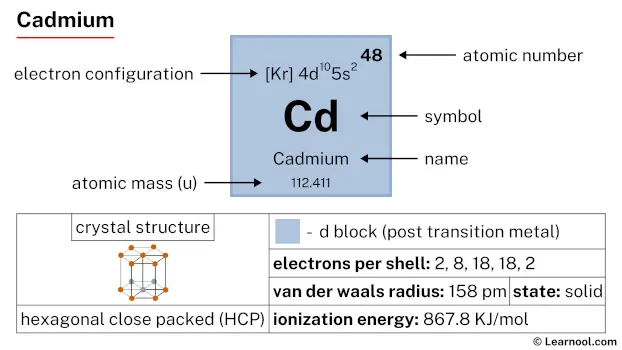
Cadmium (Cd) is a chemical element of the periodic table, located in the group 12 and the period 5, and is having the atomic number 48. It is a soft, lustrous, malleable, silvery-white post transition metal, whose name comes from the Latin word “cadmia”, which means the mineral calamine.
On periodic table
| group | ⇨ | 1 | 2 | 3 | 4 | 5 | 6 | 7 | 8 | 9 | 10 | 11 | 12 | 13 | 14 | 15 | 16 | 17 | 18 |
| period | ⇩ | ||||||||||||||||||
| 1 | 1 H 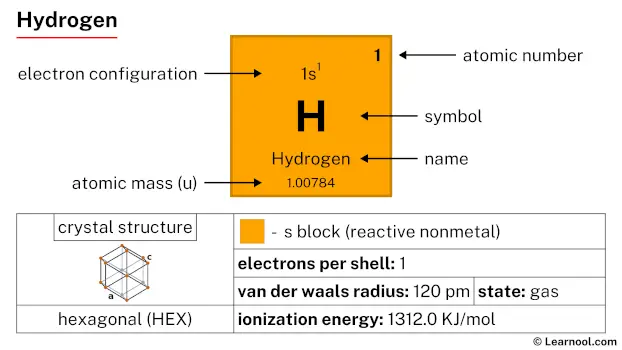 Hydrogen |
2 He  Helium |
|||||||||||||||||
| 2 | 3 Li  Lithium |
4 Be 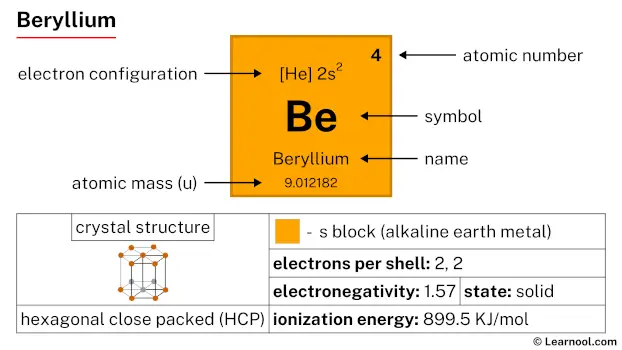 Beryllium |
5 B 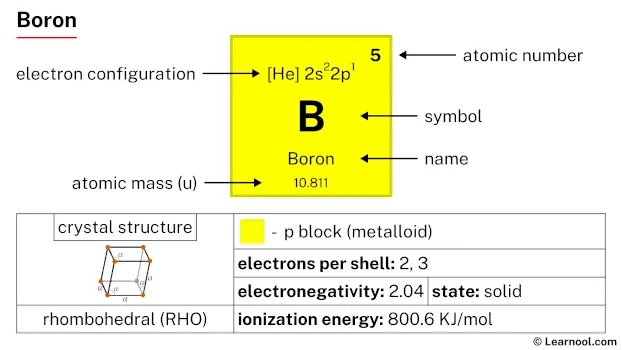 Boron |
6 C  Carbon |
7 N 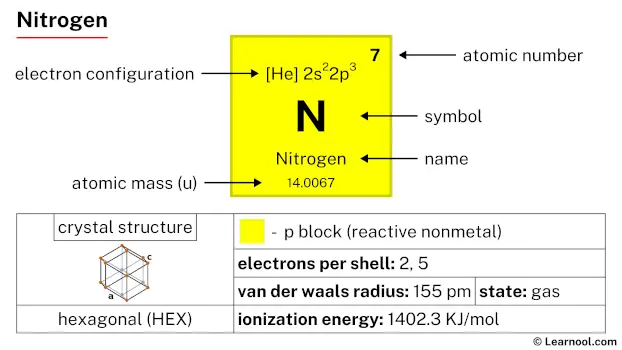 Nitrogen |
8 O 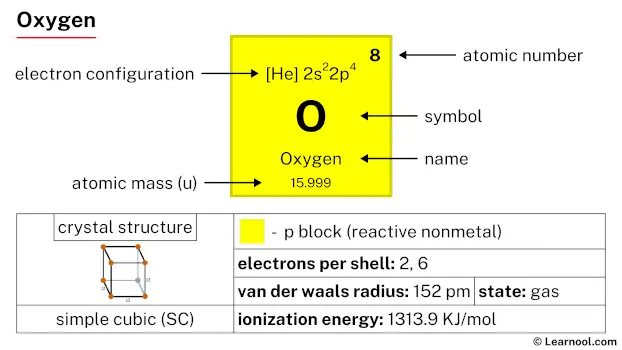 Oxygen |
9 F 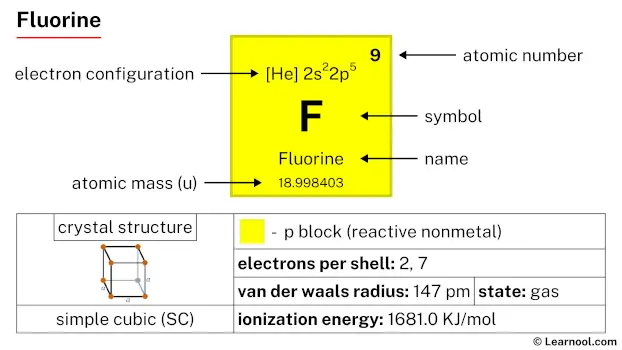 Fluorine |
10 Ne 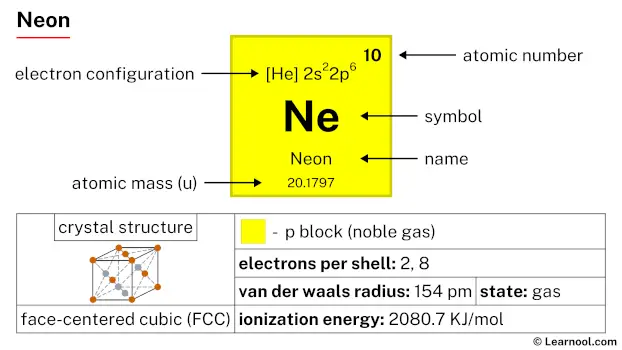 Neon |
|||||||||||
| 3 | 11 Na 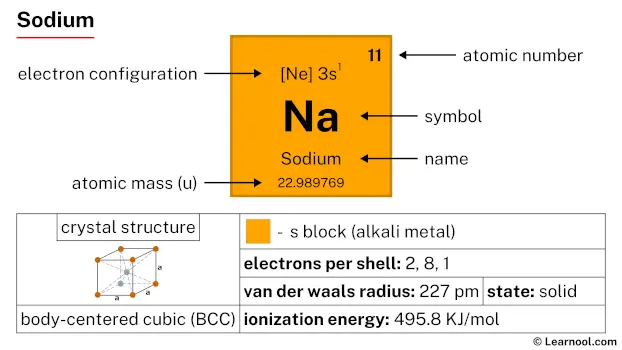 Sodium |
12 Mg 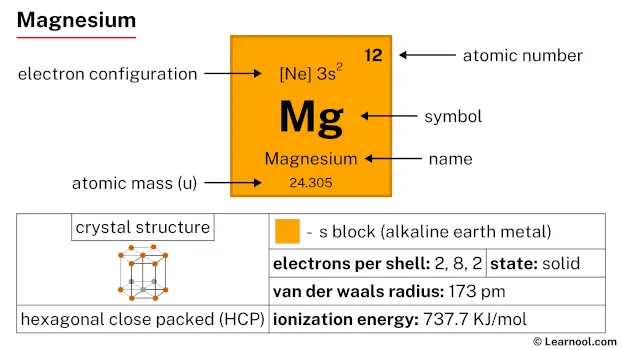 Magnesium |
13 Al  Aluminium |
14 Si Silicon |
15 P 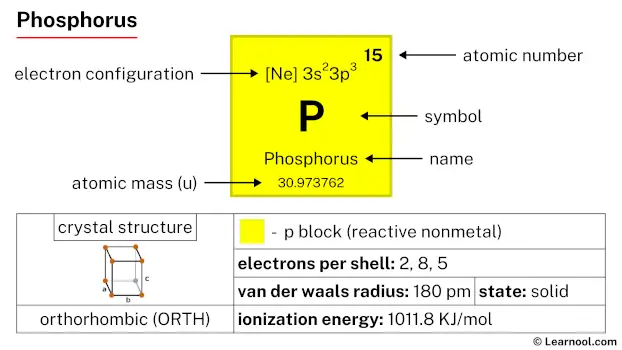 Phosphorus |
16 S 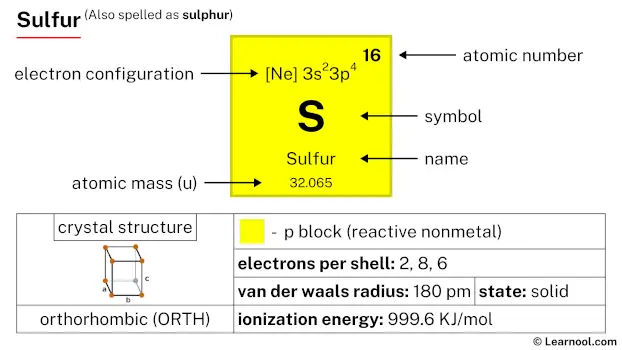 Sulfur |
17 Cl 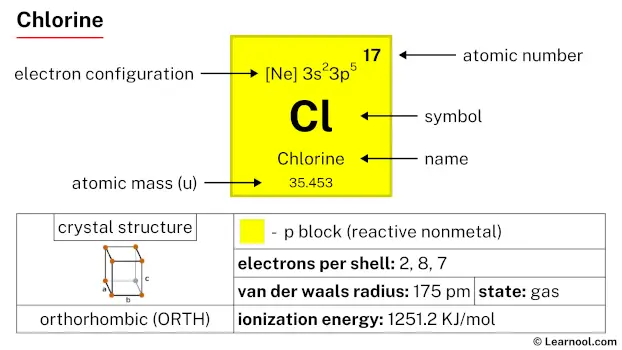 Chlorine |
18 Ar 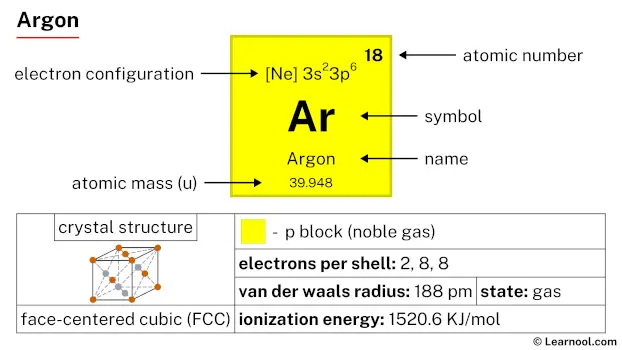 Argon |
|||||||||||
| 4 | 19 K 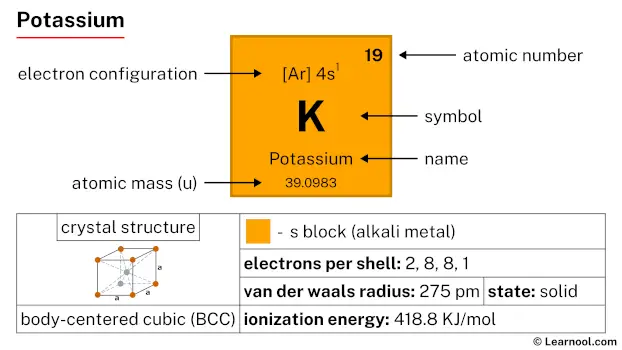 Potassium |
20 Ca 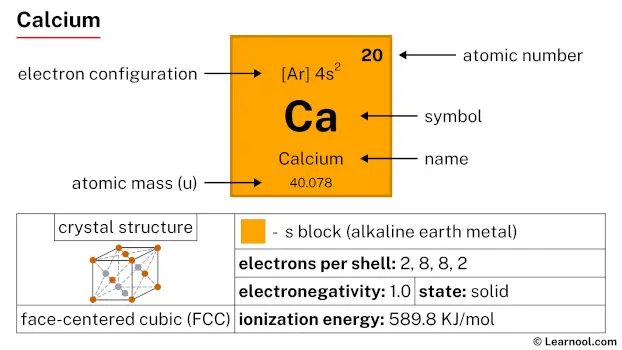 Calcium |
21 Sc 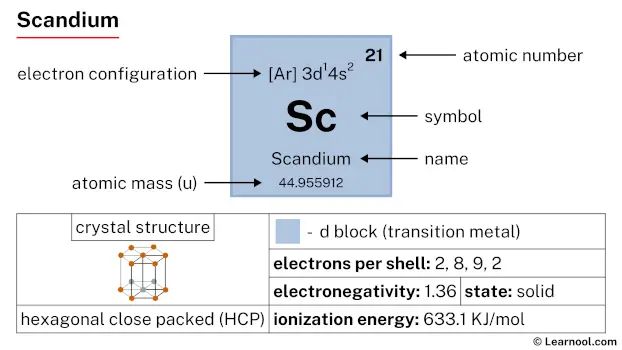 Scandium |
22 Ti 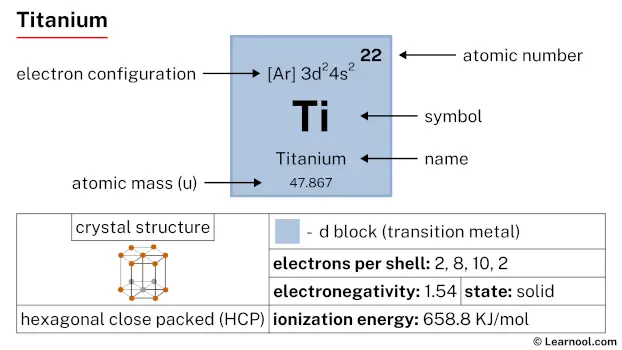 Titanium |
23 V 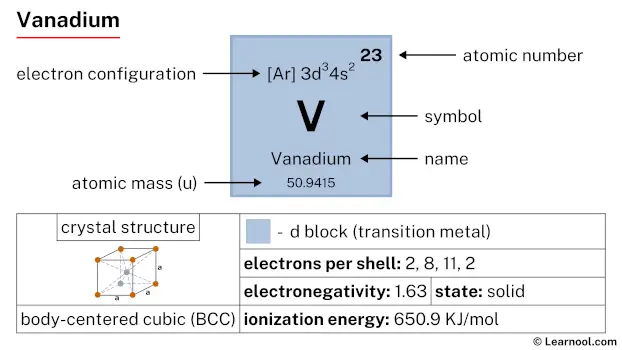 Vanadium |
24 Cr 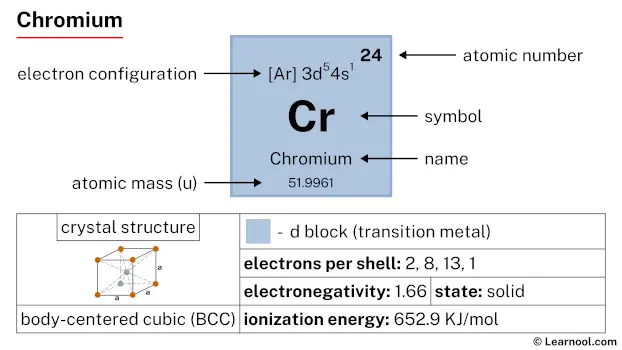 Chromium |
25 Mn 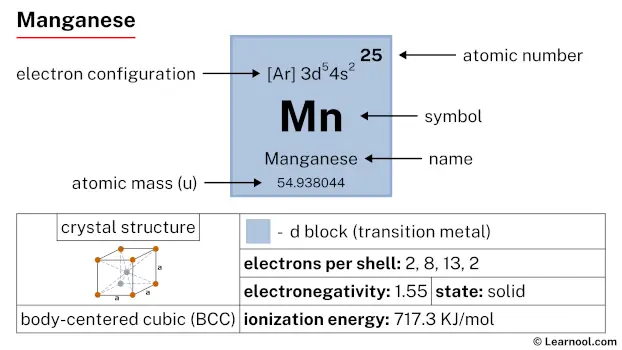 Manganese |
26 Fe 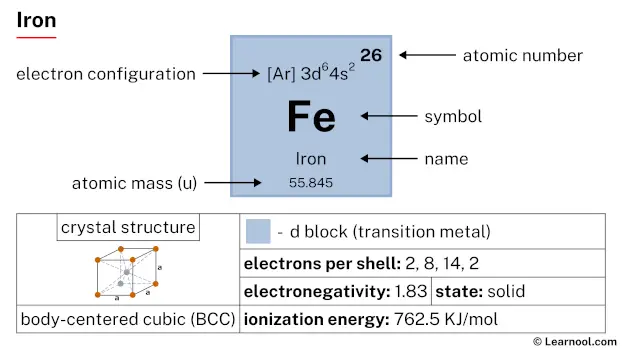 Iron |
27 Co 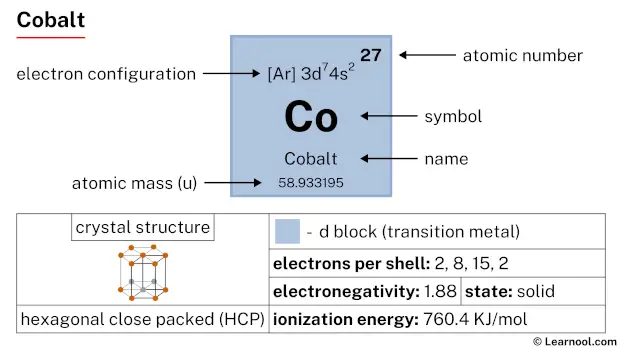 Cobalt |
28 Ni 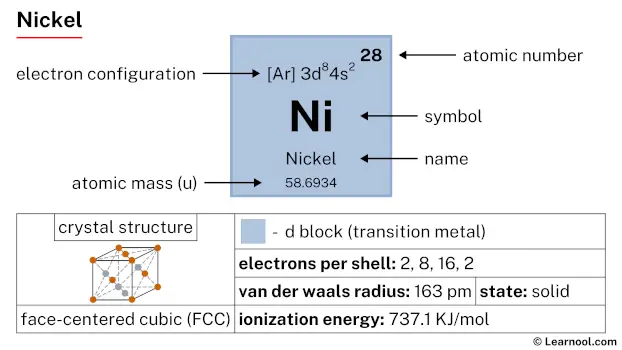 Nickel |
29 Cu 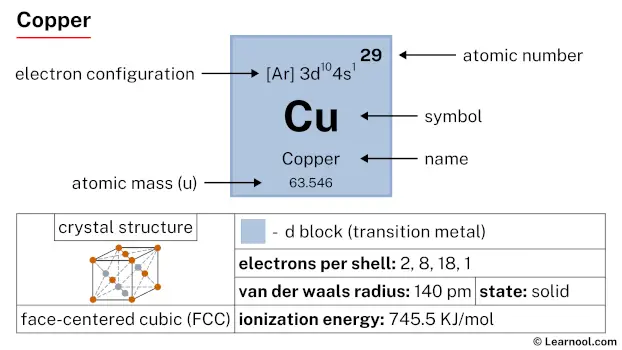 Copper |
30 Zn  Zinc |
31 Ga 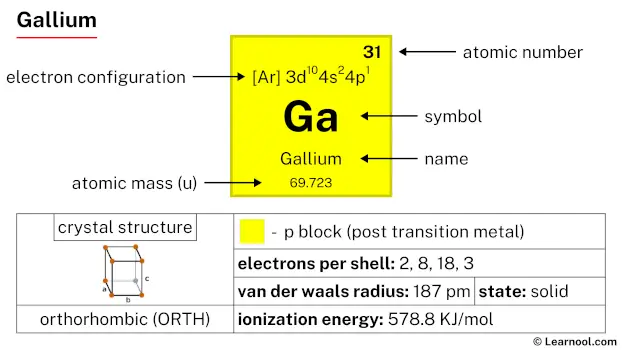 Gallium |
32 Ge 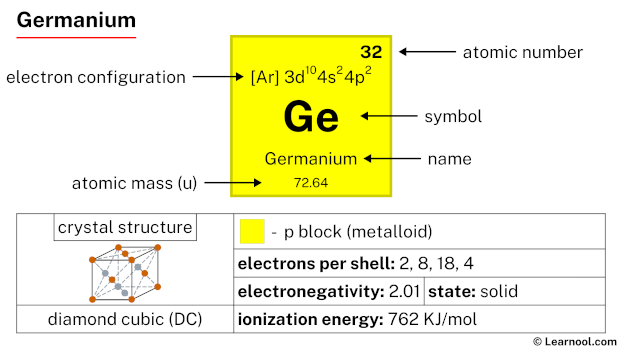 Germanium |
33 As 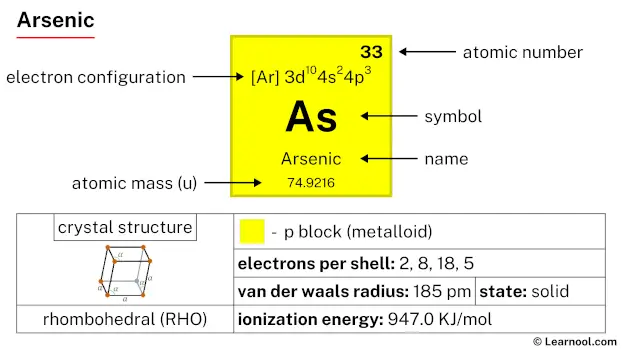 Arsenic |
34 Se 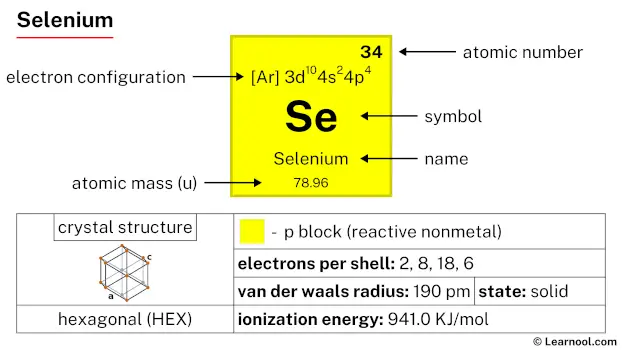 Selenium |
35 Br 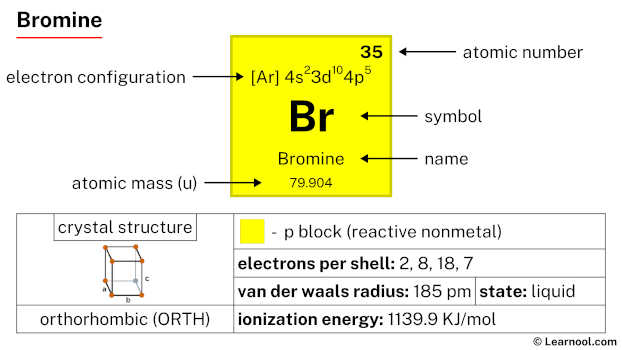 Bromine |
36 Kr  Krypton |
|
| 5 | 37 Rb 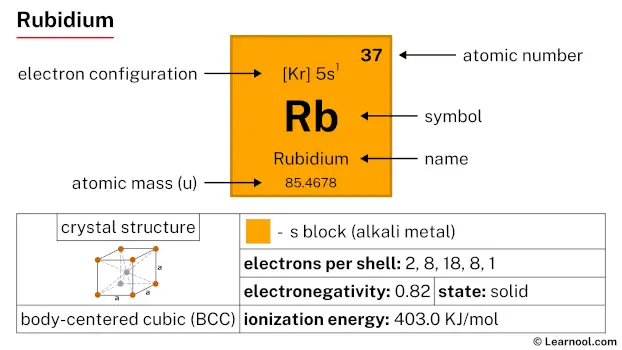 Rubidium |
38 Sr 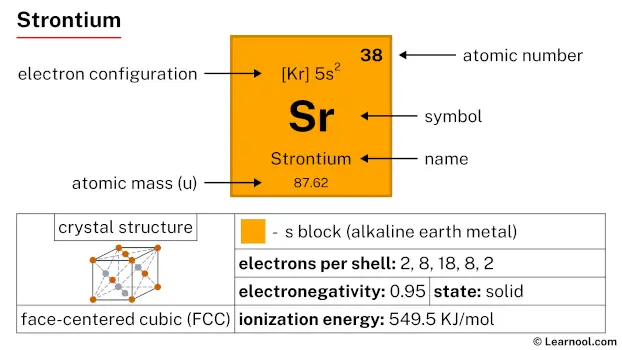 Strontium |
39 Y 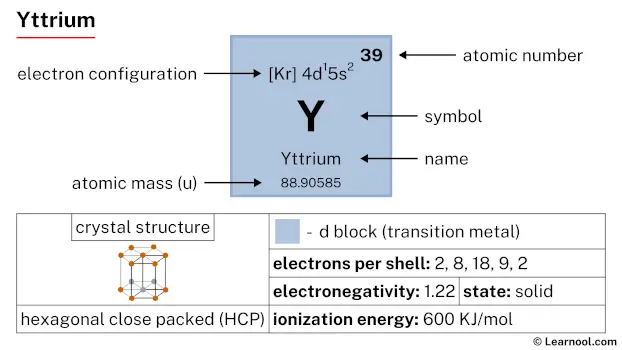 Yttrium |
40 Zr 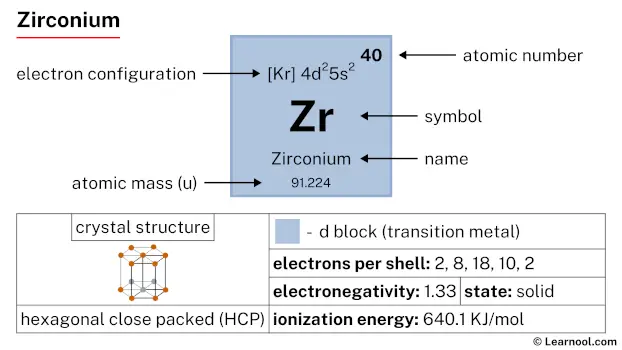 Zirconium |
41 Nb 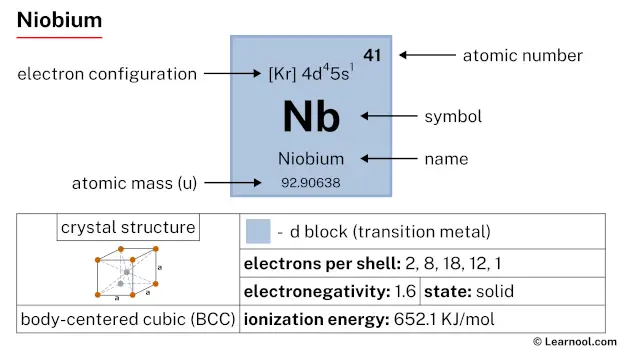 Niobium |
42 Mo 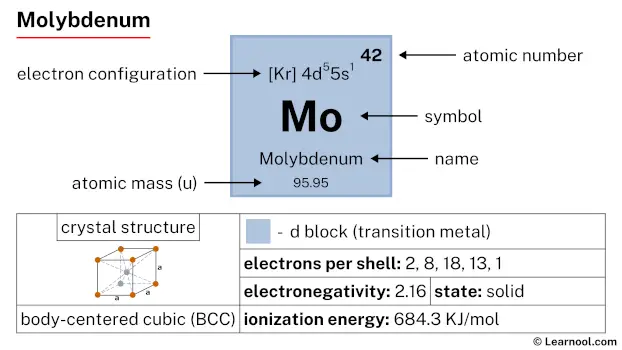 Molybdenum |
43 Tc 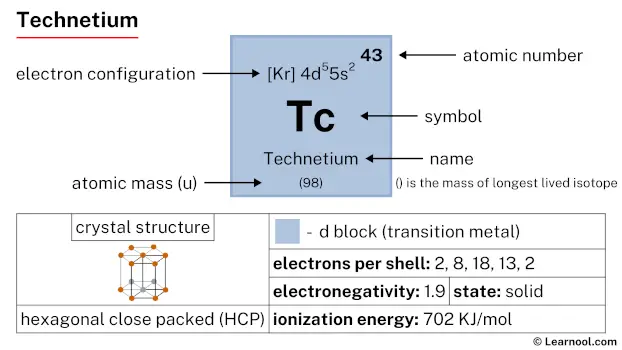 Technetium |
44 Ru 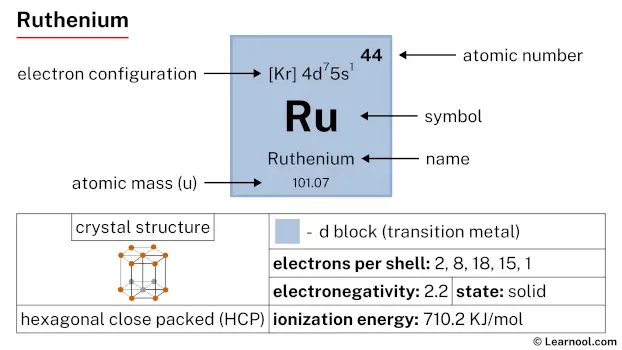 Ruthenium |
45 Rh 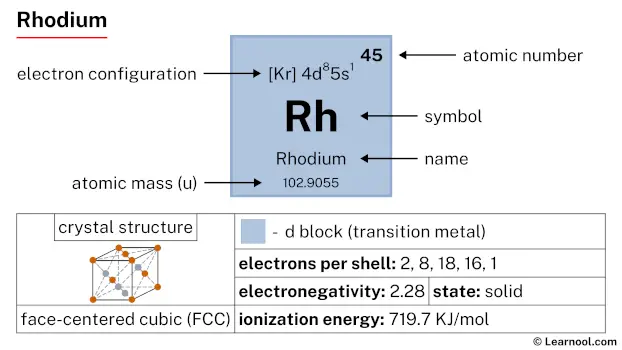 Rhodium |
46 Pd  Palladium |
47 Ag  Silver |
48 Cd Cadmium |
49 In 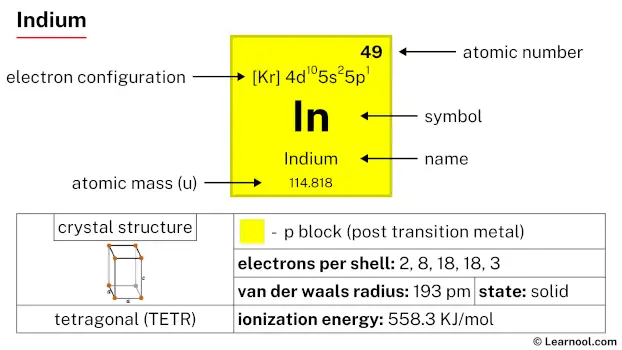 Indium |
50 Sn 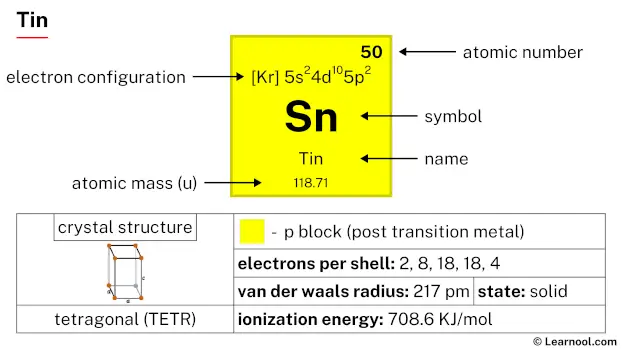 Tin |
51 Sb 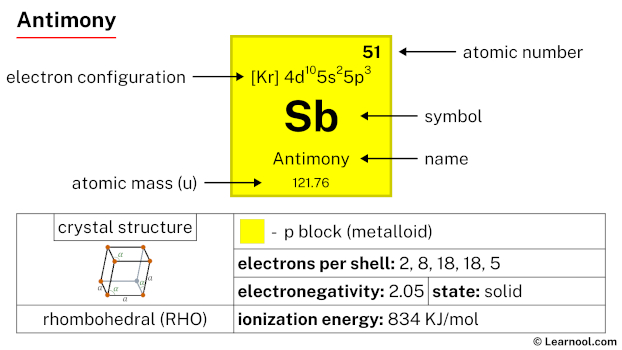 Antimony |
52 Te 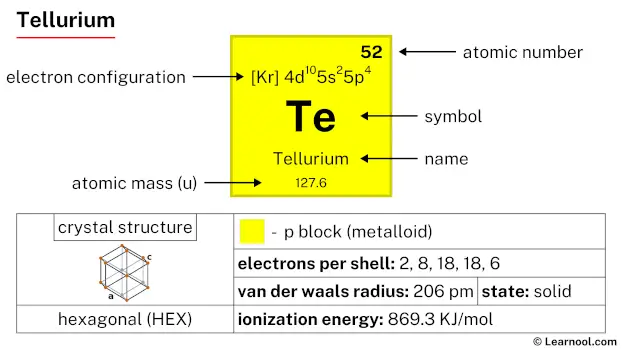 Tellurium |
53 I 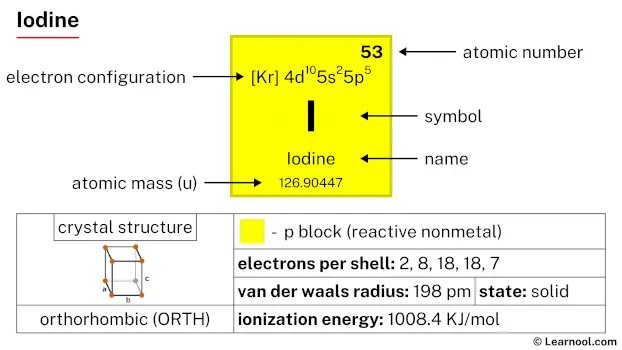 Iodine |
54 Xe 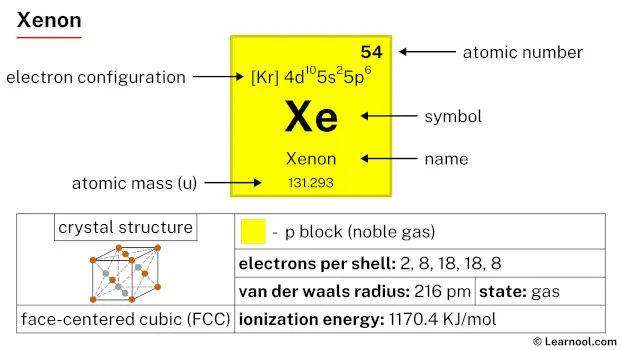 Xenon |
|
| 6 | 55 Cs 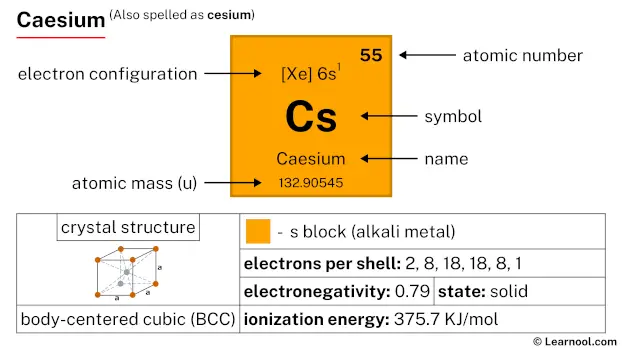 Caesium |
56 Ba 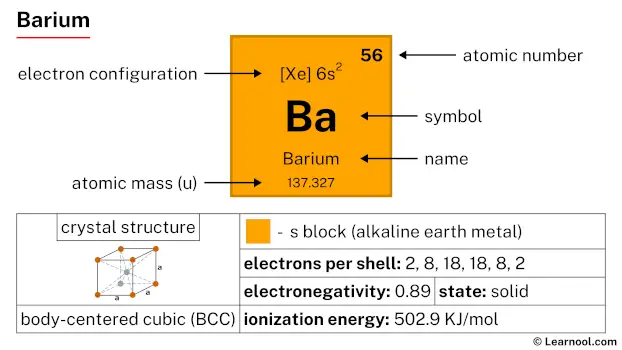 Barium |
72 Hf 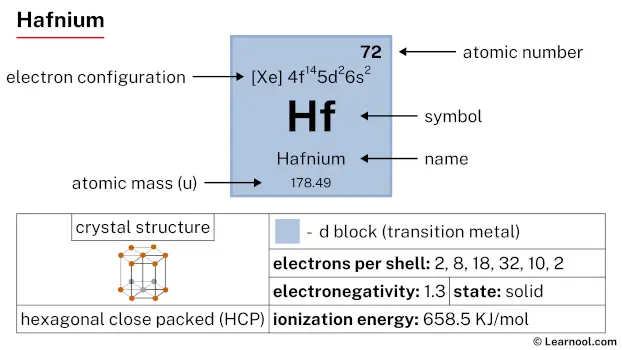 Hafnium |
73 Ta 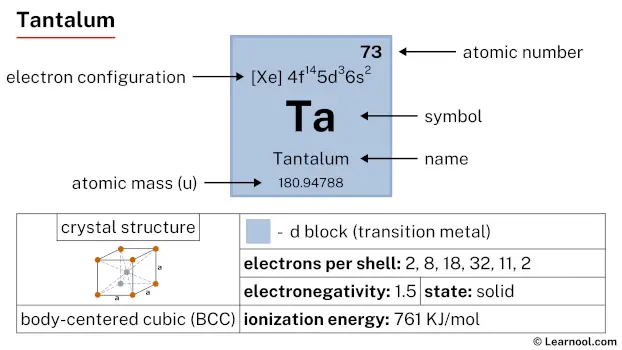 Tantalum |
74 W 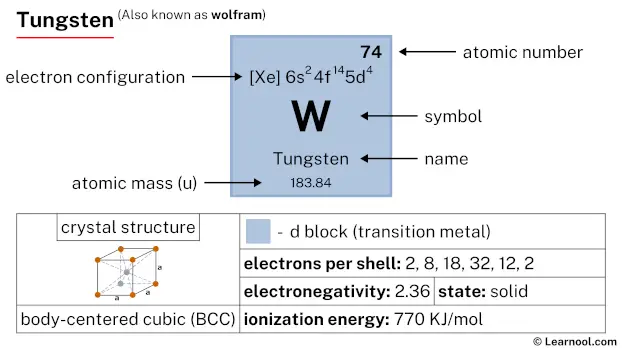 Tungsten |
75 Re 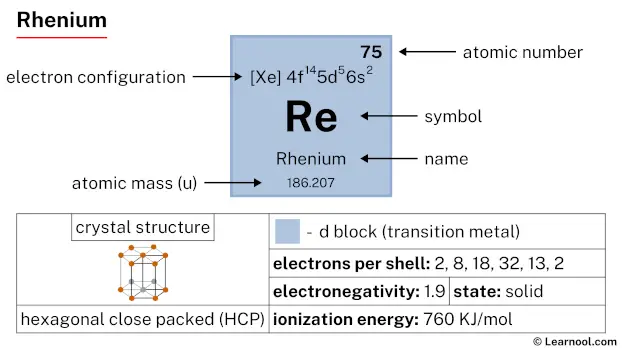 Rhenium |
76 Os 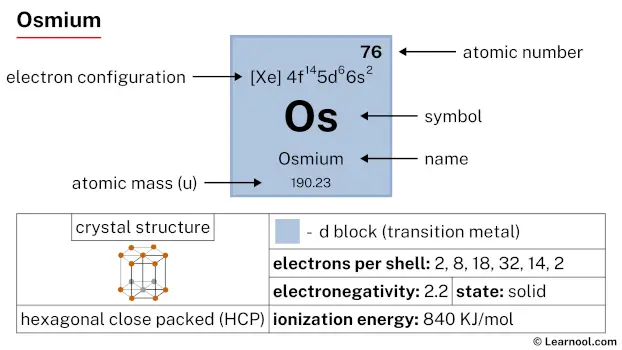 Osmium |
77 Ir 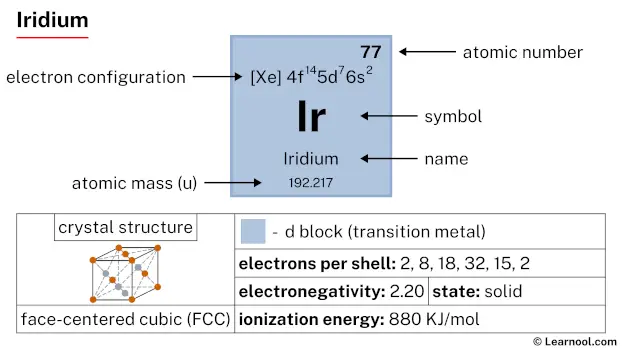 Iridium |
78 Pt  Platinum |
79 Au  Gold |
80 Hg 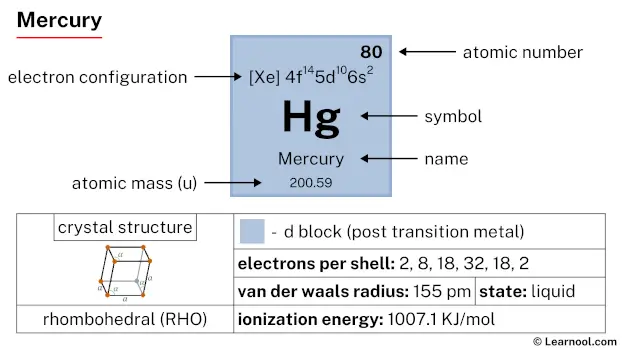 Mercury |
81 Tl 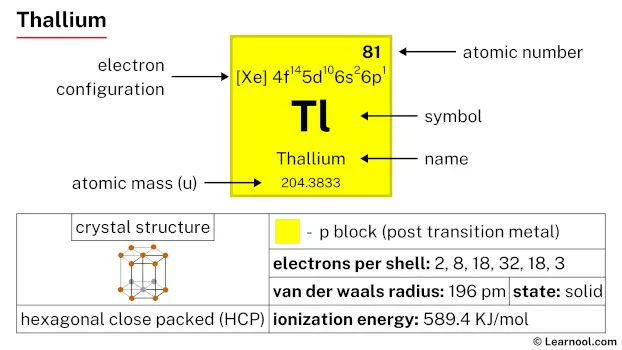 Thallium |
82 Pb  Lead |
83 Bi 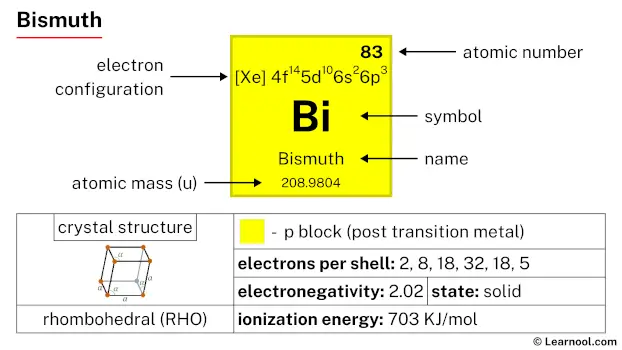 Bismuth |
84 Po 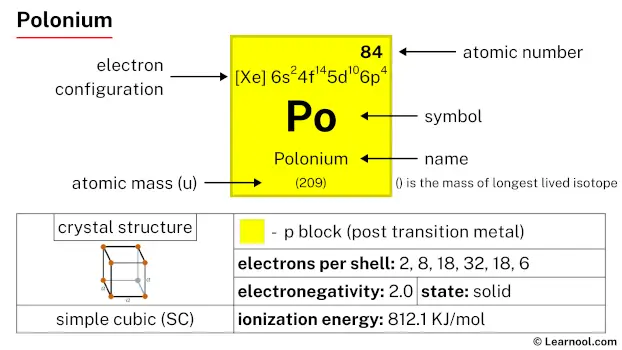 Polonium |
85 At 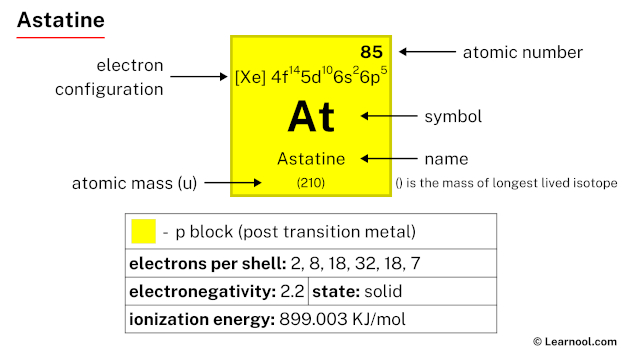 Astatine |
86 Rn 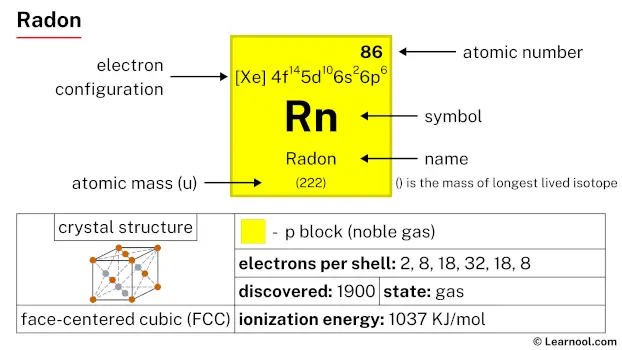 Radon |
||
| 7 | 87 Fr 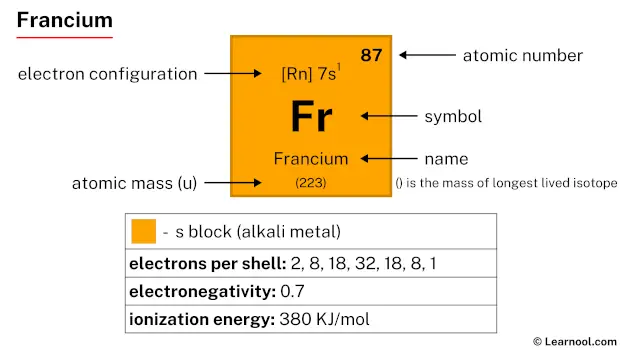 Francium |
88 Ra 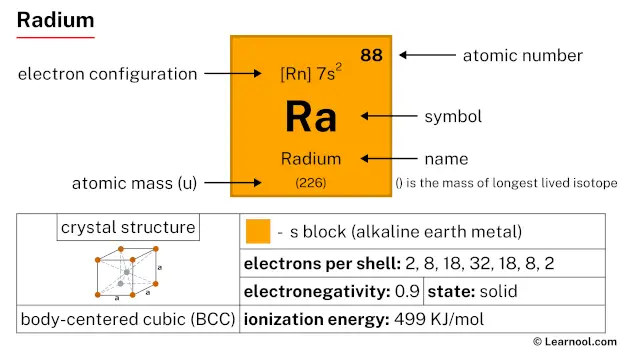 Radium |
104 Rf 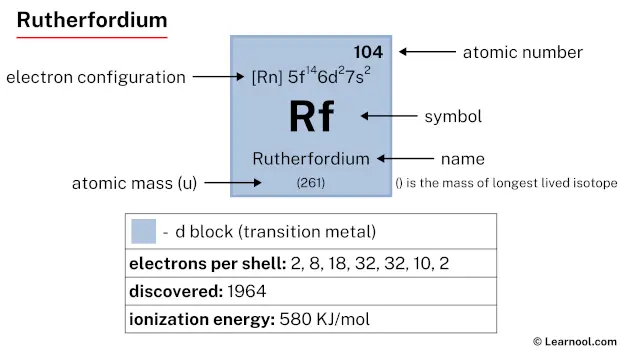 Rutherfordium |
105 Db 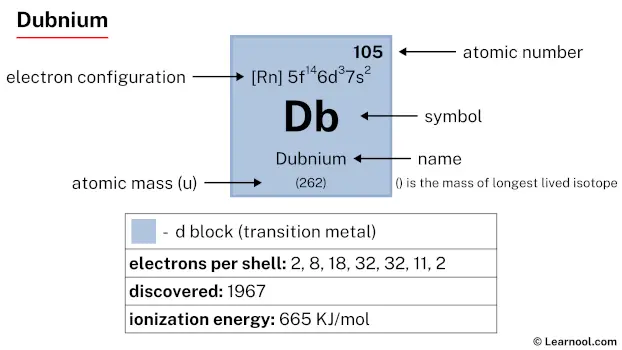 Dubnium |
106 Sg 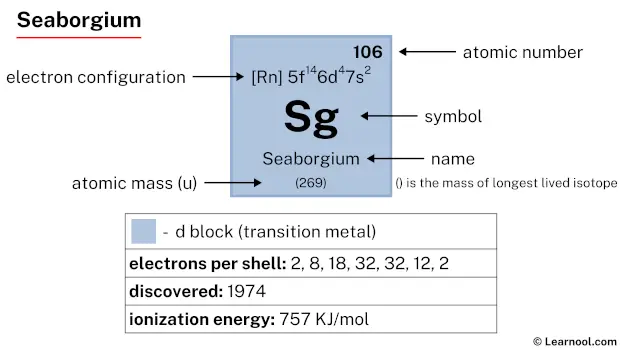 Seaborgium |
107 Bh 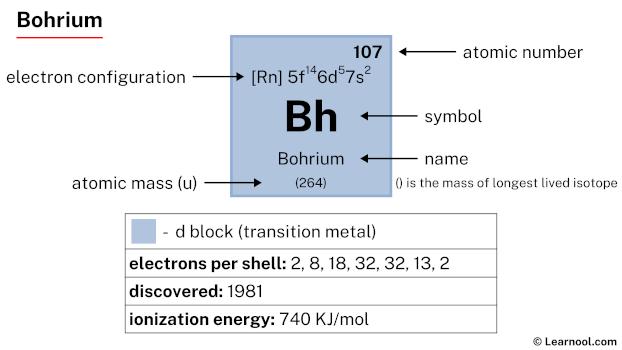 Bohrium |
108 Hs 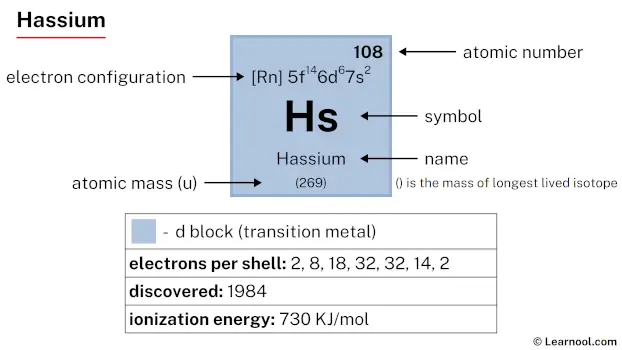 Hassium |
109 Mt 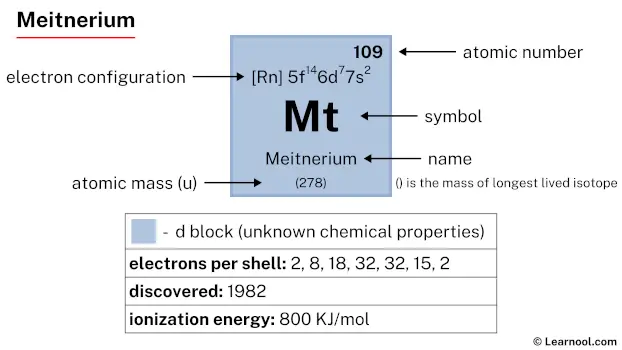 Meitnerium |
110 Ds 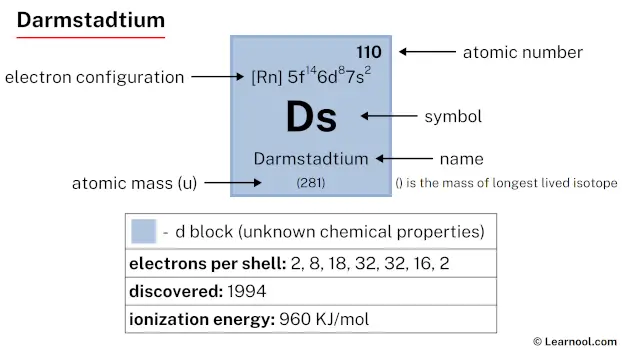 Darmstadtium |
111 Rg 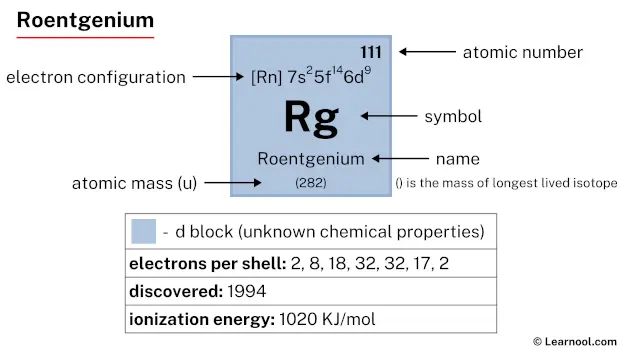 Roentgenium |
112 Cn  Copernicium |
113 Nh 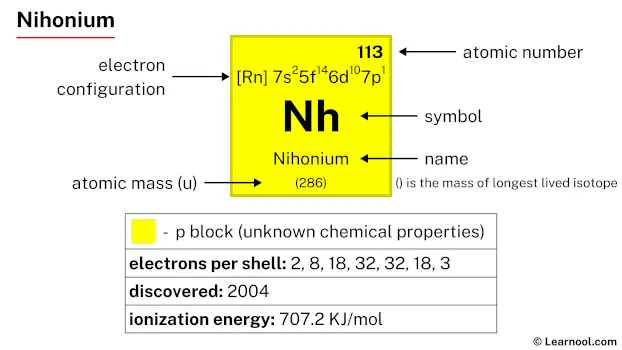 Nihonium |
114 Fl 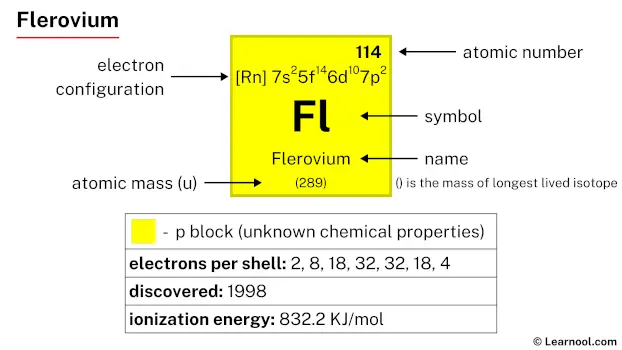 Flerovium |
115 Mc 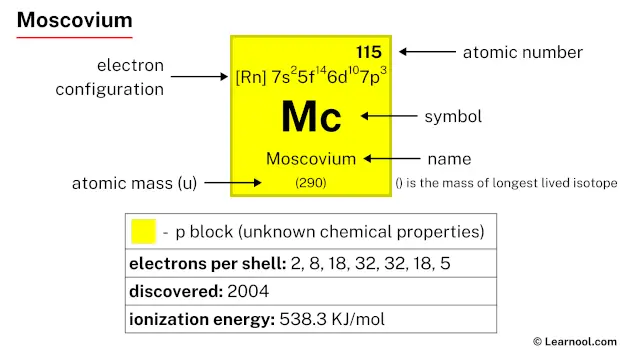 Moscovium |
116 Lv 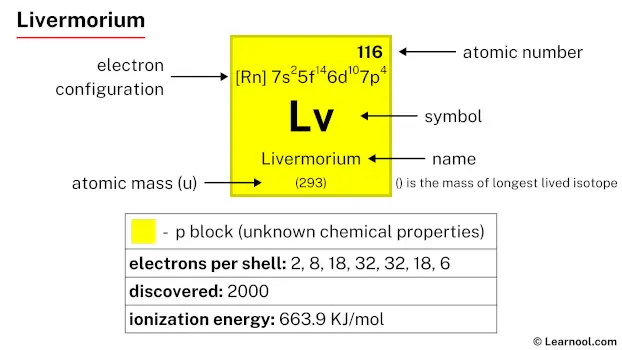 Livermorium |
117 Ts 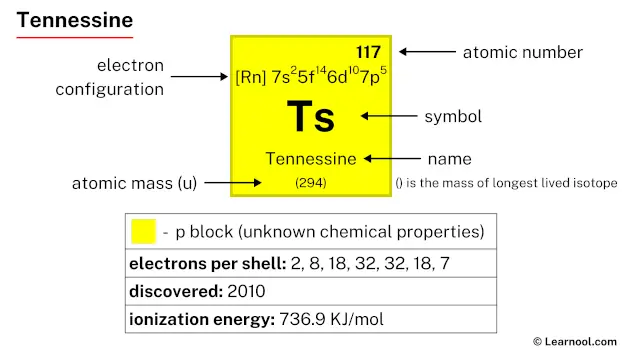 Tennessine |
118 Og 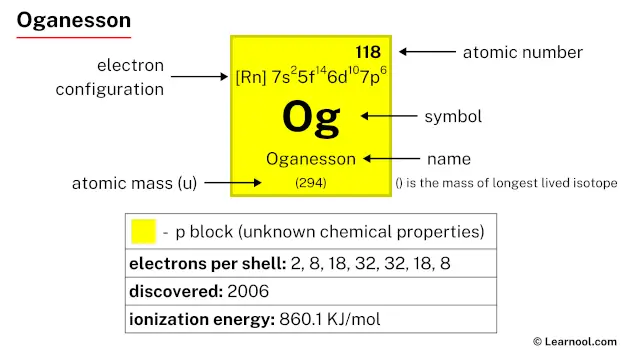 Oganesson |
||
| 57 La 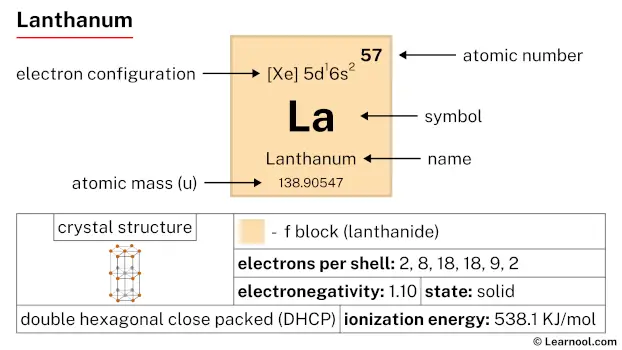 Lanthanum |
58 Ce 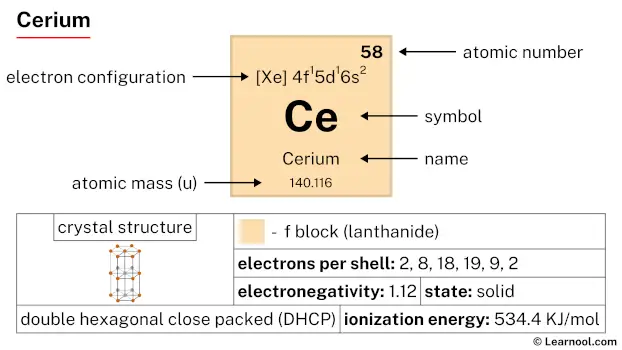 Cerium |
59 Pr 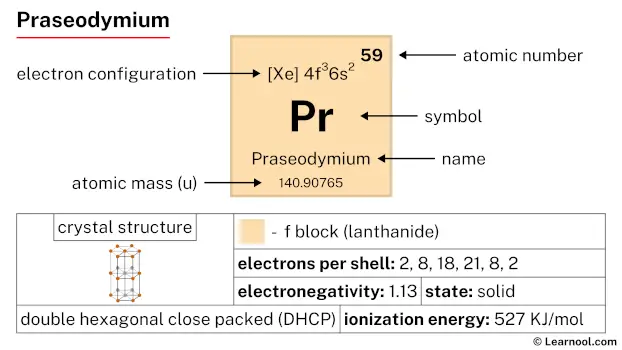 Praseodymium |
60 Nd 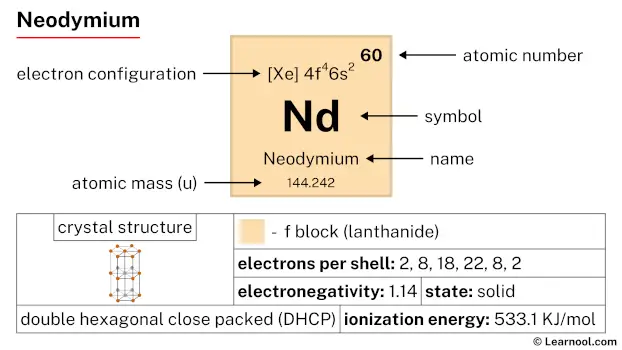 Neodymium |
61 Pm 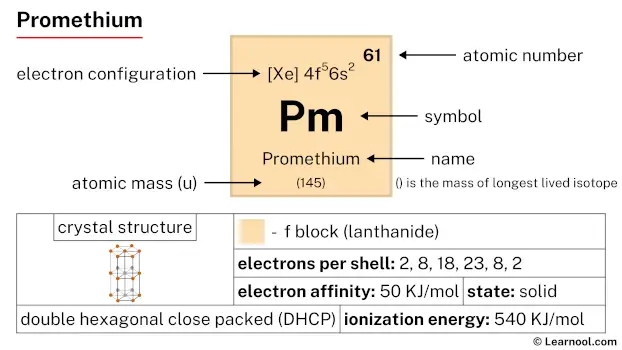 Promethium |
62 Sm 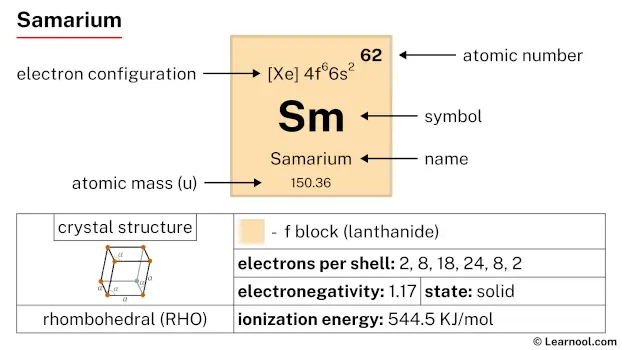 Samarium |
63 Eu 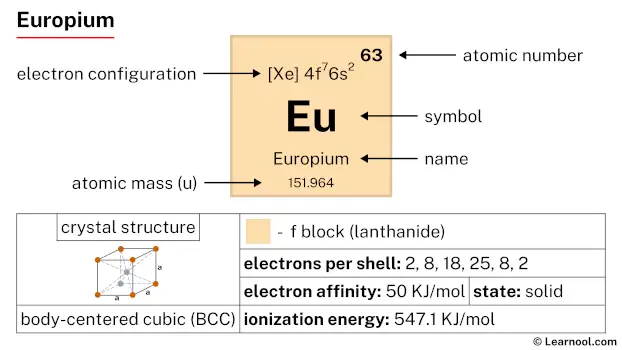 Europium |
64 Gd 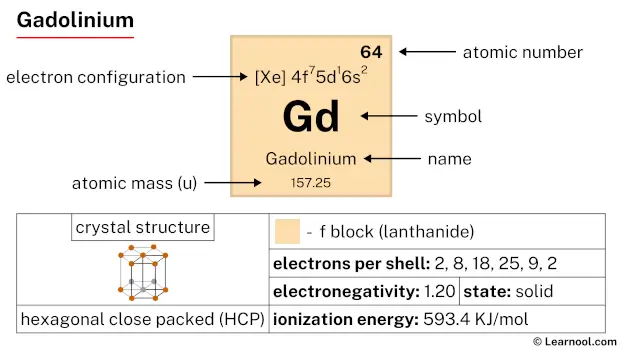 Gadolinium |
65 Tb 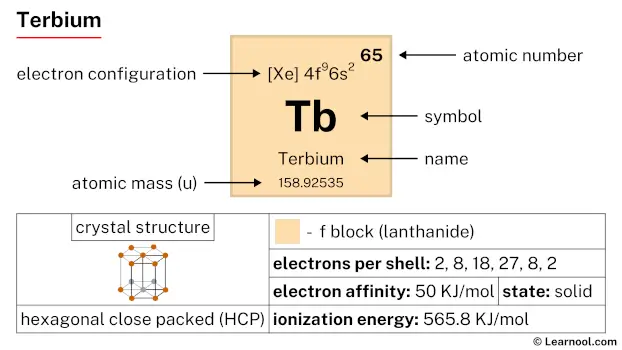 Terbium |
66 Dy 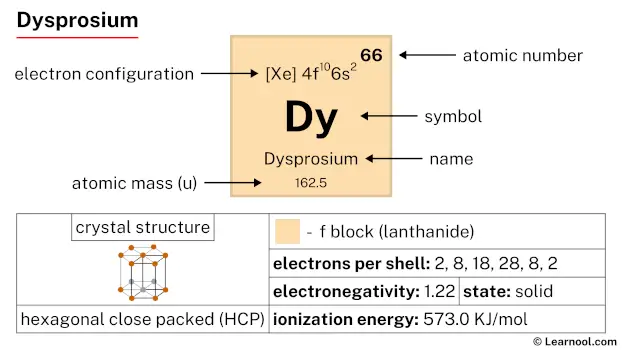 Dysprosium |
67 Ho 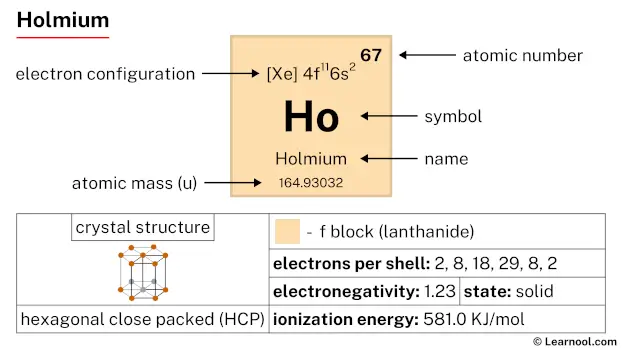 Holmium |
68 Er 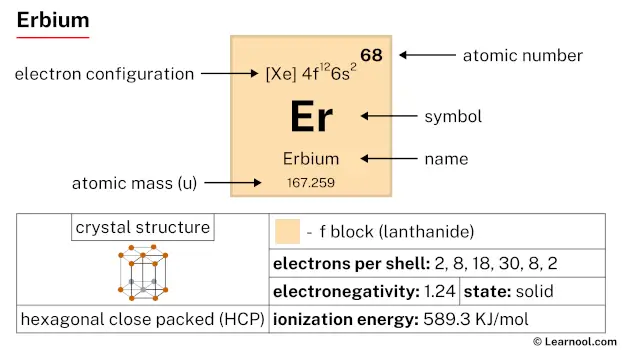 Erbium |
69 Tm 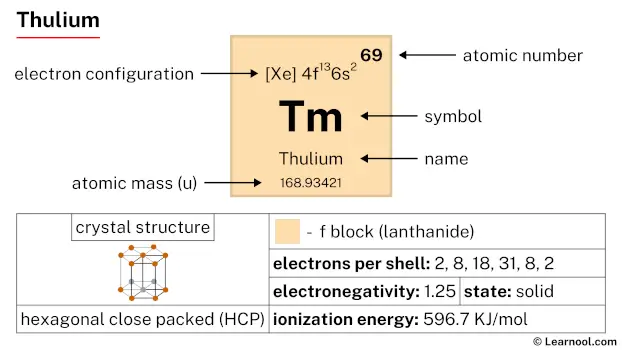 Thulium |
70 Yb 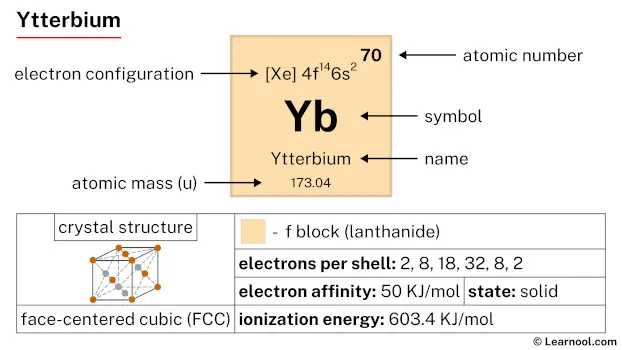 Ytterbium |
71 Lu 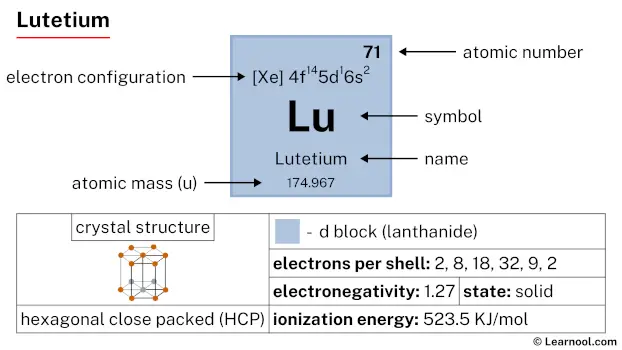 Lutetium |
|||||
| 89 Ac 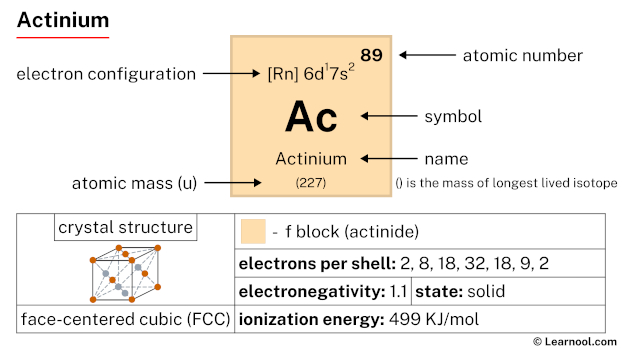 Actinium |
90 Th 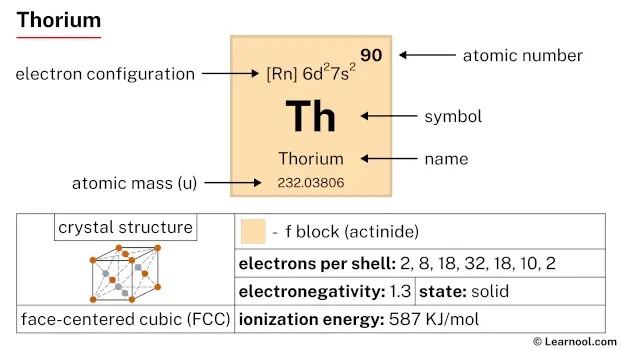 Thorium |
91 Pa 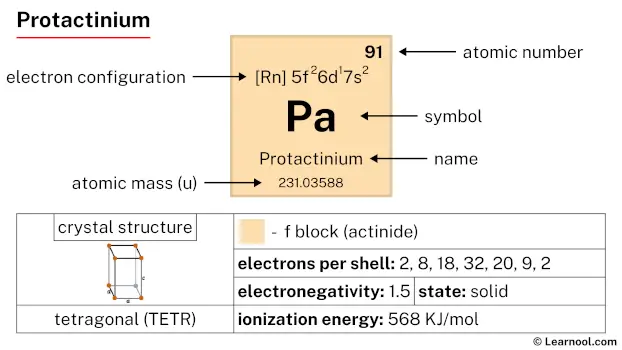 Protactinium |
92 U 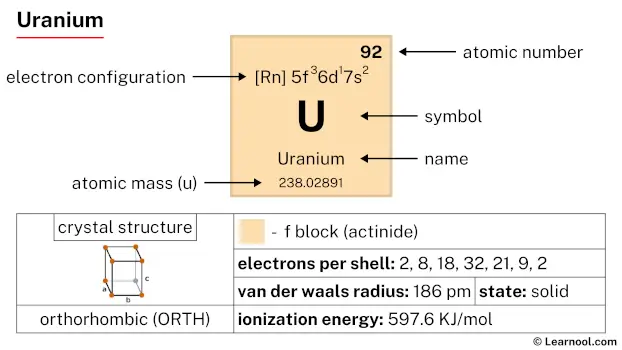 Uranium |
93 Np 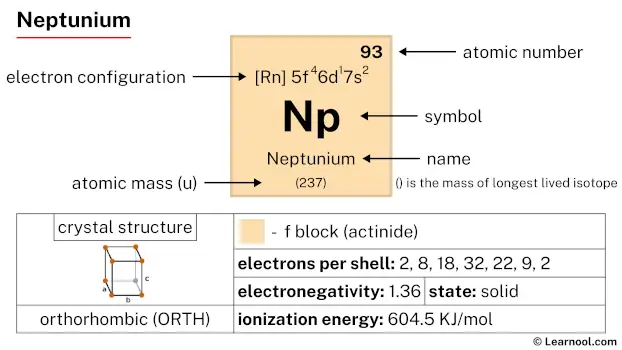 Neptunium |
94 Pu 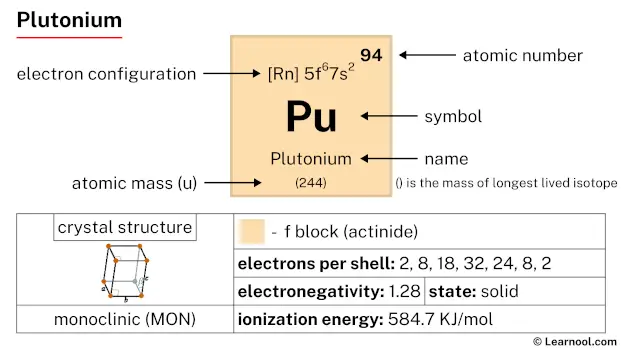 Plutonium |
95 Am  Americium |
96 Cm 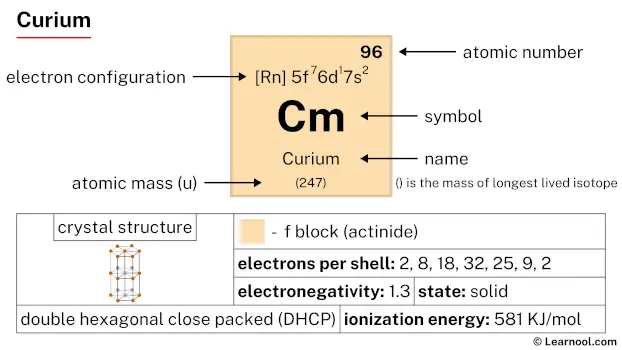 Curium |
97 Bk 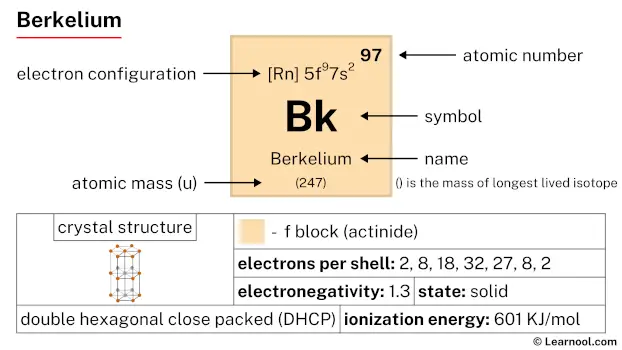 Berkelium |
98 Cf 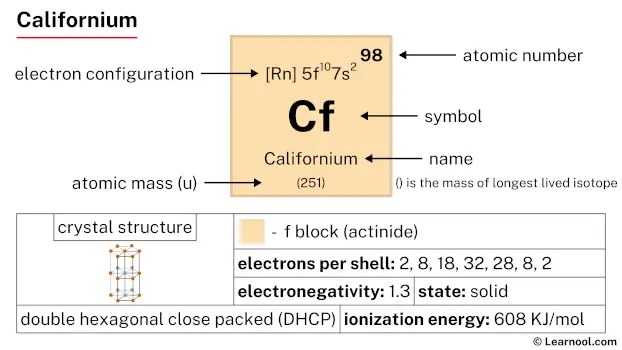 Californium |
99 Es 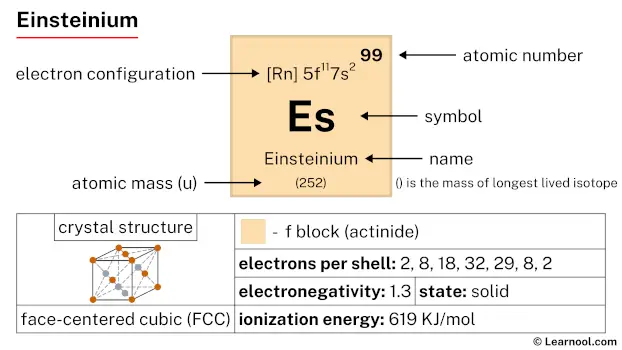 Einsteinium |
100 Fm 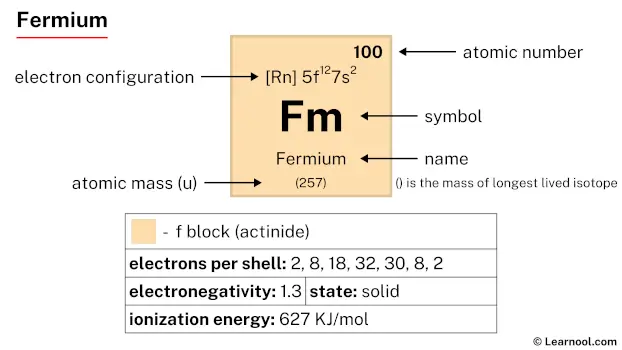 Fermium |
101 Md 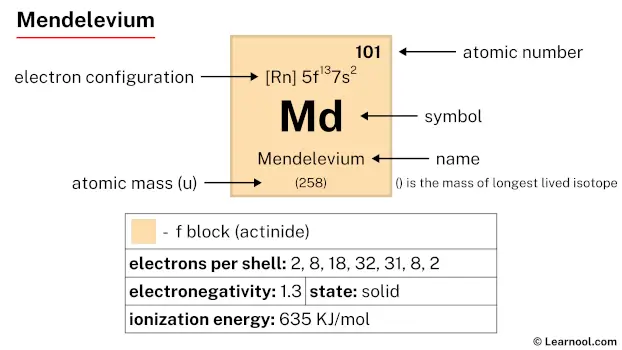 Mendelevium |
102 No 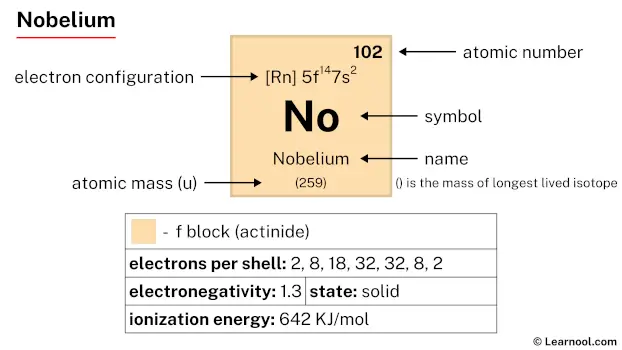 Nobelium |
103 Lr 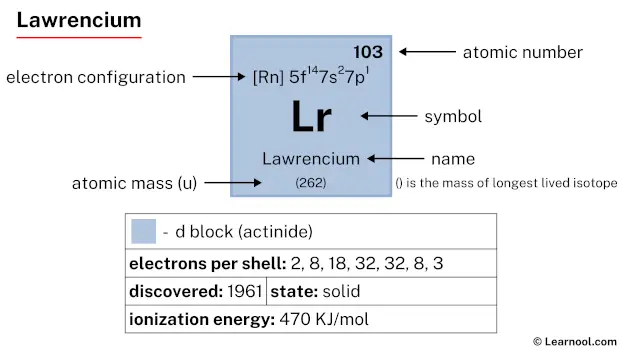 Lawrencium |
|||||
| – d block |
Cadmium is a d-block element, situated in the twelfth column and the fifth row of the periodic table, denoted by the atomic number 48 and chemical symbol Cd.
Element information
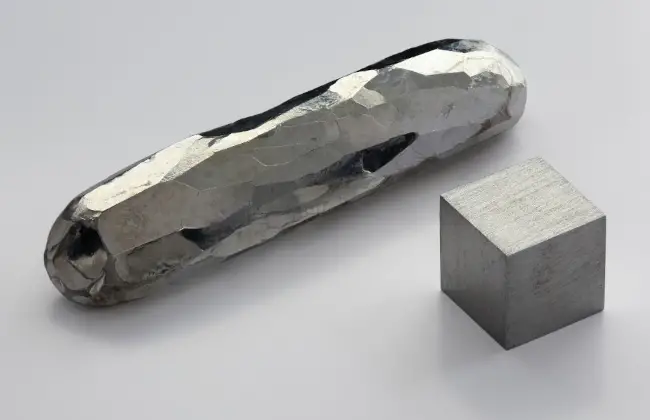 |
|
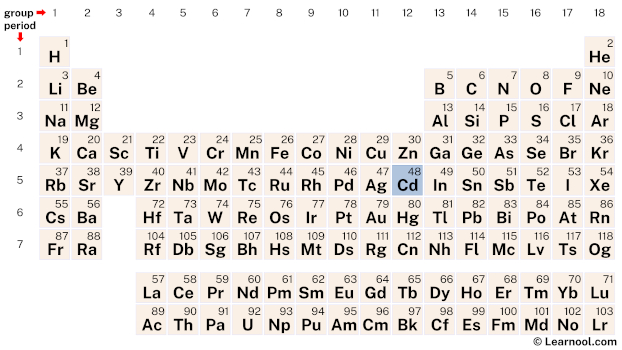 |
|
| Origin of name | Latin word “cadmia” (which means mineral calamine) |
| Symbol | Cd |
| Atomic number (Z) | 48 |
| Atomic mass | 112.411 u |
| Block | d-block |
| Group | 12 |
| Period | 5 |
| Classification | Post-transition metal |
| Atomic radius | 151 pm |
| Covalent radius | 144±9 pm |
| Van der Waals radius | 158 pm |
| Melting point | 321.07 ℃, 609.93 ℉, 594.22 K |
| Boiling point | 767 ℃, 1413 ℉, 1040 K |
| Electron configuration | [Kr] 4d10 5s2 |
| Learn how to write: Cadmium electron configuration | |
| Electrons per shell | 2, 8, 18, 18, 2 |
| Learn how to draw: Cadmium Bohr model | |
| Crystal structure | Hexagonal close-packed (hcp) |
| Phase at r.t | Solid |
| Density near r.t | 8.65 g/cm3 |
| Main isotopes | Cadmium-106, Cadmium-108, Cadmium-110, Cadmium-111, Cadmium-112, Cadmium-114 |
| Natural occurrence | Primordial |
| Oxidation state | +2 |
| Electronegativity (Pauling scale) | 1.69 |
| Protons Neutrons Electrons |
48 64 48 |
| Learn how to find: Cadmium protons neutrons electrons | |
| CAS number | 7440-43-9 |
| Discovered by | Karl Samuel Leberecht Hermann and Friedrich Stromeyer in 1817 |
History
Cadmium was first discovered in 1817 by German chemists Karl Samuel Leberecht Hermann and Friedrich Stromeyer. They were both studying the mineral known as calamine, which is primarily composed of zinc carbonate. While conducting their research, they observed that a particular sample of calamine produced a yellow-colored flame when heated in a Bunsen burner. This was an unusual observation, as zinc compounds typically produce a blue or green flame.
Upon further investigation, Hermann and Stromeyer isolated a new metallic element from the calamine sample. They named the element “cadmium,” after the Latin word for calamine, cadmia. Cadmium was found to be a relatively rare element, occurring in small quantities in several minerals, including greenockite, otavite, and sphalerite.
In the decades following its discovery, cadmium remained a relatively obscure element, with few practical applications. It wasn’t until the late 19th and early 20th centuries that scientists began to explore the properties of cadmium in more detail. During this time, several important discoveries were made that helped to establish the place of cadmium in the periodic table and increase its usefulness as a material.
One of the most significant developments in the history of cadmium was the discovery of its role as a component of the cadmium-selenium photovoltaic cell. This type of cell is used in the production of solar panels, and it was first developed in the 1950s. The discovery of cadmium’s photoelectric properties paved the way for the development of many other applications, including the use of cadmium in television tubes, phosphors, and semiconductors. Today, cadmium is widely used in industry, with applications ranging from batteries and pigments to nuclear reactors and electroplating.
Occurrence and production
Cadmium is a rare element that is typically found in low concentrations in the earth’s crust. It is primarily produced as a byproduct of zinc mining and refining, with over 90% of the world’s cadmium supply being produced in this way. Cadmium is most commonly found in association with zinc ores, as it often replaces zinc in the mineral sphalerite. Other sources of cadmium include lead and copper ores, as well as coal, oil, and phosphate rock.
The largest producer of cadmium is China, followed by South Korea and Japan. Other countries with significant cadmium production include Canada, Australia, and the United States. Due to its potential environmental and health impacts, the production and use of cadmium are subject to strict regulations in many countries. In addition to its use as a byproduct of zinc production, cadmium can also be produced through a variety of other methods, such as recycling of cadmium-containing materials, electroplating, and chemical synthesis.
Properties
Cadmium is a soft, bluish-white metal with a relatively low melting point of 321 ℃ and a boiling point of 767 ℃.
It has a density of 8.65 g/cm3, making it relatively dense compared to other metals.
Cadmium is a highly toxic element and can cause serious health problems if ingested or inhaled. It is classified as a carcinogen by the International Agency for Research on Cancer (IARC).
It is highly reactive and can easily form compounds with other elements, such as oxygen, sulfur, and chlorine.
Cadmium is a good conductor of electricity and is used in various electronic and electrical applications.
It is also used in the production of pigments, alloys, and batteries.
Cadmium has a relatively low thermal conductivity and is a poor thermal conductor.
It is not a very abundant element and is typically found in low concentrations in the earth’s crust, primarily as a byproduct of zinc mining and refining.
Applications
Rechargeable batteries
Cadmium was historically used in nickel-cadmium batteries due to its high energy density and long cycle life. However, due to its toxicity, this application has been largely phased out in favor of more environmentally friendly alternatives.
Pigments
Cadmium is commonly used as a pigment in plastics, ceramics, and paints due to its bright yellow, orange, and red hues. These pigments are highly stable and resist fading over time.
Plating
Cadmium is used in electroplating to provide a durable and corrosion-resistant coating on metal parts. It is particularly useful for protecting parts that will be exposed to harsh environments, such as those used in the aerospace and automotive industries.
Nuclear industry
Cadmium is used in nuclear reactors as a control rod material due to its high neutron absorption capacity. It is particularly useful in reactors that require fine control of power output.
Semiconductors
Cadmium telluride is a compound used in the manufacture of thin-film photovoltaic cells, which convert sunlight into electricity. These cells are used in solar panels and other renewable energy systems.
Alloys
Cadmium is used in small amounts to create alloys with other metals, such as copper and zinc. These alloys have a range of applications, including soldering, brazing, and welding.
Interesting facts
Cadmium is named after the Latin word “cadmia,” which refers to zinc carbonate, from which cadmium was first isolated.
Cadmium has a unique ability to absorb neutrons, making it useful in nuclear reactors and as a protective shield against radiation.
Cadmium yellow, a bright yellow pigment, was frequently used by artists such as Vincent Van Gogh, Henri Matisse, and Pierre-Auguste Renoir in their paintings.
Cadmium has been used in various applications throughout history, including as a component in ancient Chinese bronze coins and as a red pigment in ancient Egyptian art.
Cadmium is used in the production of nickel-cadmium batteries, which have a longer lifespan than traditional lead-acid batteries and are commonly used in cordless power tools and other applications.
Cadmium has been used as a coating on steel to prevent corrosion, although this practice has been largely phased out due to its toxicity.
Related
More elements
External links
- https://www.rsc.org/periodic-table/element/48/cadmium
- https://en.wikipedia.org/wiki/Cadmium
- https://www.britannica.com/science/cadmium
- https://pubchem.ncbi.nlm.nih.gov/element/Cadmium
- https://education.jlab.org/itselemental/ele048.html
- https://www.osha.gov/cadmium
- https://www.chemicool.com/elements/cadmium.html
Deep
Learnool.com was founded by Deep Rana, who is a mechanical engineer by profession and a blogger by passion. He has a good conceptual knowledge on different educational topics and he provides the same on this website. He loves to learn something new everyday and believes that the best utilization of free time is developing a new skill.
